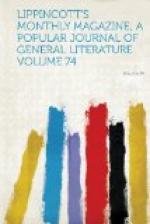The curtain down, the orchestra plays a prelude, the Chorus enters as before, and the leader speculates on Cain’s behavior. “Is he honest?”—“Ah no, his heart is full of hate: he meditates evil.” The Chorus divides as before, falls back and the curtain rises. This tableau represents the hate and rage of the people and Pharisees toward Christ, who drives the traders out of the Temple. In grouping, costume, color, tone, action and completeness it was truly a marvelous picture. The stage was crowded with figures: Christ in the centre, behind—a row of columns on each side—a scourge in his left hand, his right upheld in admirable action; in the background a group in wild confusion; on the right, richly dressed priests and Pharisees, indignant and fierce; in front, sellers of sheep and doves, money-changers and traders of various kinds. All the elements of a great picture were here shown in the highest degree, and no words of praise could be too strong to express the idea of its merits and its charm. This tableau lasted nearly two minutes, with the most complete steadiness, the basso singing an aria. The curtain then fell, and the Chorus, taking its place, sang and retired as before. This ended the first part, Cain’s hate prefiguring the hatred toward Christ.
Then came Part Second. The curtain rose on Cain by the side of his ruined in a soliloquy. Enter Abel, gentle and mild. Eve comes in, and again tries to make peace, and Cain again plays the hypocrite and invites his brother into the wood on some pretext. They retire, leaving Eve disturbed by she knows not what. Adam enters, shares her fears and goes out to seek his sons. Thunder and lightning, admirably represented, and then enter Cain disheveled and disturbed. His mother knows not what has happened, but is agonized and calls for her Abel. An angel appears at the side and discloses all by asking Cain, “Where is thy brother?” and then announcing the fiat of the Most High to him. He rushes off as Adam enters bearing the body of Abel; and his mother, sitting down beside the dead body, makes a most touching picture of a Pieta. Adam with upstretched arms appeals to God, and the curtain falls. This was the “Blutschuld”—the crime of blood—and prefigured the betrayal of Christ by Judas for the thirty pieces of silver.
After a most beautiful prelude by the orchestra, the Chorus again enters; the leader expresses his horror at Cain’s action and his pity for a fate thus given over to Satan; they again divide, and the curtain rises on the tableau of Judas receiving the money. At the end the high priest and other priests, in appropriate costume, stand on a platform beyond a railing. Judas in the centre, by a table, is taking the money from an attendant: all around are groups, admirably arranged, expressing, in face and attitude, wonder or pleasure or disgust. The same artistic ideas and beautiful arrangement and the same unaffected simplicity. This tableau lasted one minute and a half, while the tenor sang an aria, “Oh, better for him that he had never been born.”




